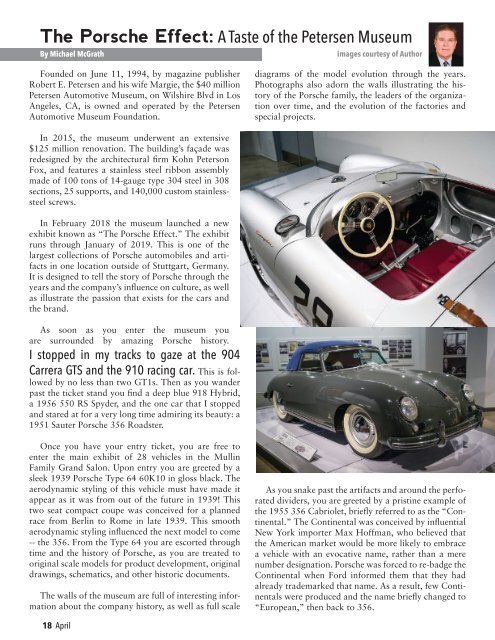Slipstream - April 2018
The monthly newsletter of the Maverick Region of the Porsche Club of America
The monthly newsletter of the Maverick Region of the Porsche Club of America
Create successful ePaper yourself
Turn your PDF publications into a flip-book with our unique Google optimized e-Paper software.
The Porsche Effect: A Taste of the Petersen Museum<br />
By Michael McGrath<br />
images courtesy of Author<br />
Founded on June 11, 1994, by magazine publisher<br />
Robert E. Petersen and his wife Margie, the $40 million<br />
Petersen Automotive Museum, on Wilshire Blvd in Los<br />
Angeles, CA, is owned and operated by the Petersen<br />
Automotive Museum Foundation.<br />
diagrams of the model evolution through the years.<br />
Photographs also adorn the walls illustrating the history<br />
of the Porsche family, the leaders of the organization<br />
over time, and the evolution of the factories and<br />
special projects.<br />
In 2015, the museum underwent an extensive<br />
$125 million renovation. The building’s façade was<br />
redesigned by the architectural firm Kohn Peterson<br />
Fox, and features a stainless steel ribbon assembly<br />
made of 100 tons of 14-gauge type 304 steel in 308<br />
sections, 25 supports, and 140,000 custom stainlesssteel<br />
screws.<br />
In February <strong>2018</strong> the museum launched a new<br />
exhibit known as “The Porsche Effect.” The exhibit<br />
runs through January of 2019. This is one of the<br />
largest collections of Porsche automobiles and artifacts<br />
in one location outside of Stuttgart, Germany.<br />
It is designed to tell the story of Porsche through the<br />
years and the company’s influence on culture, as well<br />
as illustrate the passion that exists for the cars and<br />
the brand.<br />
As soon as you enter the museum you<br />
are surrounded by amazing Porsche history.<br />
I stopped in my tracks to gaze at the 904<br />
Carrera GTS and the 910 racing car. This is followed<br />
by no less than two GT1s. Then as you wander<br />
past the ticket stand you find a deep blue 918 Hybrid,<br />
a 1956 550 RS Spyder, and the one car that I stopped<br />
and stared at for a very long time admiring its beauty: a<br />
1951 Sauter Porsche 356 Roadster.<br />
Once you have your entry ticket, you are free to<br />
enter the main exhibit of 28 vehicles in the Mullin<br />
Family Grand Salon. Upon entry you are greeted by a<br />
sleek 1939 Porsche Type 64 60K10 in gloss black. The<br />
aerodynamic styling of this vehicle must have made it<br />
appear as it was from out of the future in 1939! This<br />
two seat compact coupe was conceived for a planned<br />
race from Berlin to Rome in late 1939. This smooth<br />
aerodynamic styling influenced the next model to come<br />
-- the 356. From the Type 64 you are escorted through<br />
time and the history of Porsche, as you are treated to<br />
original scale models for product development, original<br />
drawings, schematics, and other historic documents.<br />
The walls of the museum are full of interesting information<br />
about the company history, as well as full scale<br />
As you snake past the artifacts and around the perforated<br />
dividers, you are greeted by a pristine example of<br />
the 1955 356 Cabriolet, briefly referred to as the “Continental.”<br />
The Continental was conceived by influential<br />
New York importer Max Hoffman, who believed that<br />
the American market would be more likely to embrace<br />
a vehicle with an evocative name, rather than a mere<br />
number designation. Porsche was forced to re-badge the<br />
Continental when Ford informed them that they had<br />
already trademarked that name. As a result, few Continentals<br />
were produced and the name briefly changed to<br />
“European,” then back to 356.<br />
18 <strong>April</strong>


















